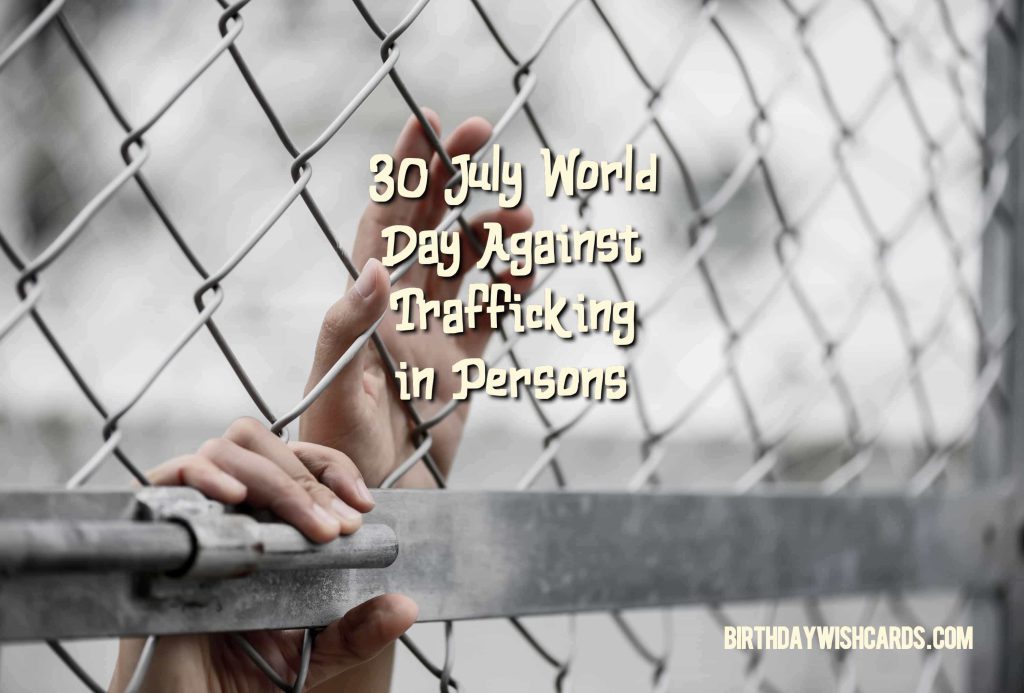
30 July: World Day Against Trafficking in Persons
United Nations Recognition and Purpose of the Day
In 2013, the United Nations General Assembly convened a high-level meeting to review the Global Plan of Action against human trafficking. During this session, Member States adopted resolution A/RES/68/192, officially designating July 30 as the World Day Against Trafficking in Persons. This day aims to raise global awareness about the plight of trafficking victims and to promote and protect their rights.
The commitment to end trafficking was further reinforced in September 2015 with the adoption of the 2030 Sustainable Development Agenda. This agenda includes specific targets to eliminate trafficking and violence against children, and to address all forms of human trafficking. It places particular emphasis on preventing violence and exploitation of women and girls, underscoring the urgent need for coordinated global action.
Global Efforts to Combat Human Trafficking
Human trafficking is a grave violation of human rights, exploiting women, children, and men for forced labor, sexual exploitation, and other forms of abuse. Since 2003, the United Nations Office on Drugs and Crime (UNODC) has collected data on approximately 225,000 detected trafficking victims worldwide. The growing number of reported cases and convictions reflects improved capacity to identify and address this crime.
In 2006, at the request of the Economic and Social Council (ECOSOC), intergovernmental agencies began collaborating to strengthen technical assistance for countries affected by trafficking. The Government of Japan hosted a coordination meeting for international agencies involved in anti-trafficking efforts. Key organizations—including the International Labour Organization (ILO), International Organization for Migration (IOM), United Nations Children’s Fund (UNICEF), UN Women, United Nations High Commissioner for Refugees (UNHCR), and UNODC—agreed to a unified approach, resulting in the formation of the Inter-Agency Coordination Group Against Trafficking in Persons (ICAT) in March 2007.
In 2010, the General Assembly adopted the Global Plan of Action to Combat Trafficking in Persons, urging all governments to implement coordinated and consistent measures to eradicate trafficking. The plan also called for integrating anti-trafficking initiatives into broader United Nations frameworks focused on development and global security.
A notable element of the plan is the establishment of a UN Voluntary Trust Fund for Victims of Trafficking in Persons, especially women and children. This fund provides essential, direct support through grants to specialized non-governmental organizations (NGOs), prioritizing victims affected by armed conflict and those among large refugee and migration flows.
Countries Most Affected by Human Trafficking
While human trafficking is a global issue, certain countries are identified as major sources or destinations for victims. The United States, for example, ranks among the countries with the highest incidence of human trafficking. According to the U.S. Department of State, the top three countries of origin for trafficking victims in 2018 were the United States, Mexico, and the Philippines.
These countries face complex challenges involving trafficking networks, forced labor, sexual exploitation, and other forms of modern slavery. Addressing these issues requires comprehensive strategies, including law enforcement, victim support services, and international cooperation.
Understanding Human Trafficking: Key Facts and Figures
- Human trafficking involves the recruitment, transportation, transfer, harboring, or receipt of persons through force, fraud, or coercion for the purpose of exploitation.
- Victims are subjected to forced labor, sexual exploitation, domestic servitude, forced marriage, and other abuses.
- Women and children are disproportionately affected, representing the majority of detected trafficking victims worldwide.
- Traffickers exploit vulnerabilities such as poverty, lack of education, social instability, and conflict.
- Global efforts focus on prevention, victim protection, prosecution of traffickers, and partnerships between governments and civil society.
International Legal Frameworks and Protocols
The fight against human trafficking is underpinned by key international legal instruments. The United Nations Protocol to Prevent, Suppress and Punish Trafficking in Persons, Especially Women and Children—known as the Palermo Protocol—supplements the UN Convention against Transnational Organized Crime. It provides a comprehensive definition of trafficking and outlines measures for prevention, protection, and prosecution.
Many countries have incorporated these protocols into national legislation, strengthening their ability to combat trafficking through enhanced laws, victim assistance programs, and cross-border cooperation.
The Role of Civil Society and NGOs
Civil society organizations and NGOs are central to the global response against human trafficking. They provide direct support to victims—such as shelter, medical care, legal aid, and psychological counseling—as well as conduct awareness campaigns, train law enforcement, and advocate for stronger policies.
Collaboration among governments, international organizations, and NGOs has led to more effective victim identification and the dismantling of trafficking networks. Public engagement, including community vigilance and education, is vital to prevent trafficking and protect vulnerable populations.
How Individuals Can Help Fight Human Trafficking
- Educate yourself and others: Learn to recognize the signs of trafficking and understand the tactics traffickers use.
- Support survivors: Donate to reputable organizations assisting trafficking survivors, or volunteer your time and skills.
- Advocate for policy change: Engage with policymakers to strengthen anti-trafficking laws and victim support services.
- Report suspicious activity: If you suspect trafficking, contact local authorities or dedicated hotlines.
The Significance of World Day Against Trafficking in Persons
The World Day Against Trafficking in Persons is a global call to action. It highlights the urgent need to protect victims, hold perpetrators accountable, and address the root causes of trafficking. Each year, events and campaigns around the world raise public awareness, honor survivors, and renew commitments from governments and organizations.
By breaking the silence around trafficking, this day empowers individuals and communities to take a stand. It also underscores the importance of international cooperation and comprehensive strategies to eradicate trafficking in all its forms.
Conclusion
Human trafficking remains one of the most serious violations of human rights worldwide. The United Nations’ designation of July 30 as the World Day Against Trafficking in Persons reflects a shared commitment to end this crime. Through coordinated action by governments, international agencies, NGOs, and individuals, progress continues toward a world where everyone can live in dignity and freedom.
For more information on combating human trafficking, visit the UNODC Human Trafficking Portal. The U.S. Department of State’s Office to Monitor and Combat Trafficking in Persons also provides comprehensive reports and resources on global trafficking trends and prevention.




